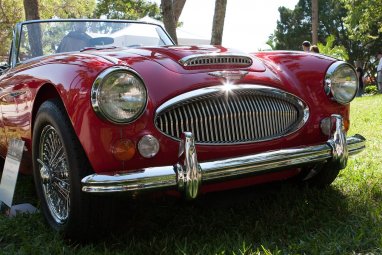Cars are more than just a means of transportation; they are history, culture, design and engineering. You can immerse yourself in this atmosphere, trace the evolution of the automotive industry and see legendary models with your own eyes by visiting one of the many automobile museums around the world.
Auto town Volkswagen. In the heart of Wolfsburg, Germany, where the main Volkswagen plant is located, there is a real “auto town” - an entire theme park dedicated to the world of this legendary brand.
On an area of 25 hectares there are restaurants, museums, an entertainment center, and the headquarters of the board of directors of the automaker. The main buildings of the complex are the 20-story twin towers, where on each floor there are brand new, already purchased cars, each of which is thoroughly adapted to the needs of its happy owner.
The Petersen Automotive Museum is located in Los Angeles. Founded in 1994, it houses one of the most extensive car collections in the world.
150 models, from vintage rarities to modern supercars, tell a fascinating story of the development of the automotive industry. Walking around the first floor, you will immerse yourself in the atmosphere of the birth of the automobile industry, learn about the first experiments and feel the spirit of the pioneers.
The second floor is dedicated to Hollywood stars and their luxury cars. Here you can see Batman's personal car, legendary cars from “The Great Race” and other icons of automotive cinema.
Models of children's vehicles await little visitors on the third floor.
Mercedes-Benz Museum in Stuttgart (Germany). The futuristic building in the form of a spiral rushes up 9 floors.
At the main entrance you are greeted not just by an exhibit, but by a legend - the Mercedes-Benz W196 racing car, driven by the great racing driver Juan Manuel Fangio, immortalized in bronze. This car is also called the “Silver Arrow”.
Unusually, the journey starts from the 9th floor. The museum’s rich collection, numbering more than 1500 exhibits, includes not only cars and trucks, but also motorcycles, buses and even special equipment.
The National Chevrolet Corvette Museum in Bowling Green (USA) was created not for commercial gain, but to glorify and preserve the history of one of the most legendary American cars, it has become a real home and mecca for Corvette fans from all over the world.
It is no coincidence that the museum complex is located across the street from the only plant where these famous cars were produced. Here you can trace the evolution of the Corvette from the very first model released in 1953 to the supercars of today.
Toyota Mega Web in Tokyo. Here, on six show floors, hundreds of Toyota models of all sizes and ages are on display.
The heart of the complex is the Toyota City Showcase, where you can see all the existing and future models of the brand. Next to it is the most popular hall - Ride One, where everyone can ride in a luxury car of the latest model. The short but exciting 1,3 km ride through three pavilions will leave you with an unforgettable experience.
Automobile Museum “Mille Miglia” in Brescia (Italy). The unique museum is dedicated to the endurance racing on public roads that took place in Italy between 1927 and 1957. Housed in the historic stone chambers of the former monastery of St. Eufemia, it invites you on a journey through the time and history of this exciting competition.
The museum halls are built on the principle of a long enfilade, where about 30 unique cars are arranged in chronological order along the walls. Walk through this car parade and you will be able to see the legends of the 20s, 30s, 40s and 50s who once raced along the roads of Italy at incredible speeds.
National Studebaker Museum in South Bend (USA). The museum introduces visitors to the rich history of the Studebaker brand and displays an impressive collection of 120 exhibits.
The ground floor displays the company's early creations: from carts and vans produced since 1852 to cars of the early XX century. The second floor is dedicated to the golden age of Studebaker, featuring models produced since 1934, including the famous “nosy” cars of the 50s. On the next level there is an exhibition of Studebaker military equipment.
Among the collection's gems are four presidential carriages, the first and last Studebaker, and Packard automobiles and concept cars. And also, an electric car from 1902, ahead of its time.
Henry Ford Museum in Detroit (USA). Founded in 1929 by Henry Ford himself, this museum complex occupies an area of more than 18 hectares.
The Henry Ford Museum collection, which began to gather in 1906, today includes a huge number of exhibits of interest to a wide audience.
Walking through the museum, visitors will be able to see dozens of models of cars, trucks, agricultural machinery, engines, airplanes, trains, motorcycles, etc.
A special place in the exhibition is occupied by the 1961 Lincoln Continental presidential limousine in which John F. Kennedy was shot.
Ferrari Car Museum in Modena (Italy). The exhibition space is divided into 6 halls, each of which is dedicated to a specific page in the history of the legendary brand: the Competition Hall, the Hall of Fame, the Conceptual Hall, the Grand Tours Hall, the cinema hall and the hall of temporary exhibitions.
Among the exhibits are exhibition cars, unique cars, powerful engines, wheels that preserve the memory of hot races, treasured trophies captured in photographs and paintings.
Visitors can literally “look inside” these iron horses, examining every piston, valve and lever up close.
The museum displays both the latest models, fresh off the production line, and rare race cars that shone on the tracks in the middle of the last century.
The “BMW World” museum and multifunctional exhibition center in Munich (Germany) is dedicated to the history and innovations of the legendary automaker.
Built in the early 2000s according to a design by the Austrian bureau Coop Himmelb(l)au, “BMW World” is striking at first glance. The dynamic, streamlined shape of the building, seemingly floating in the air, symbolizes BMW's commitment to speed and perfection.
Resource: autoblog.md
Also read:














